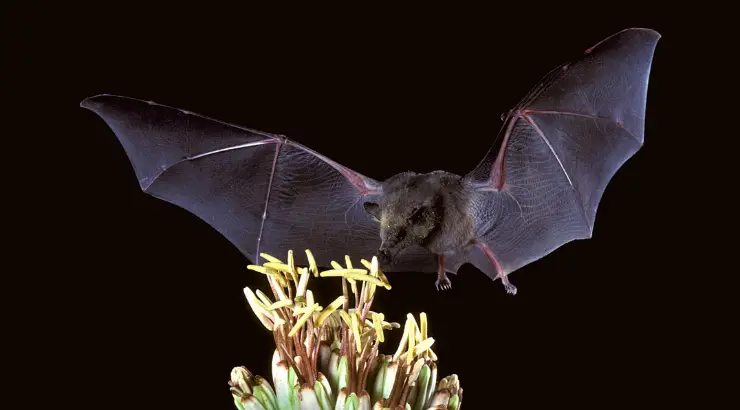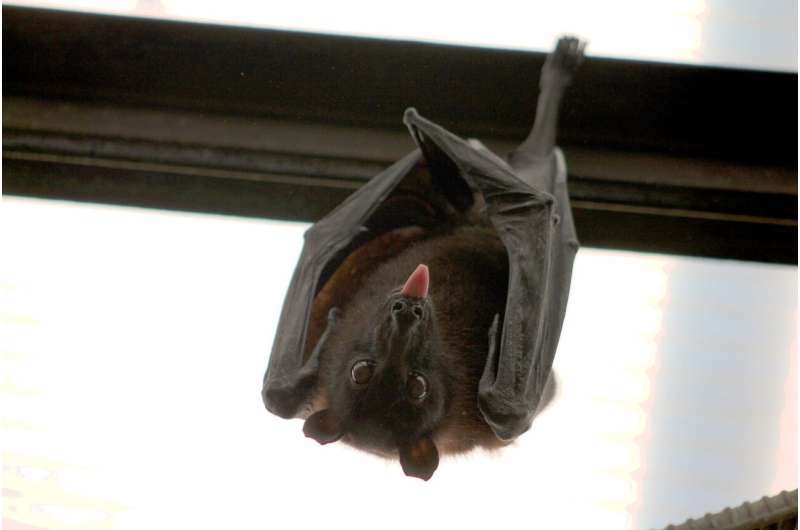Fruit, nectar, bugs and blood: How bat teeth and jaws evolved for a diverse dinnertime
IMAGE:
THIS JAMAICAN FRUIT BAT, ARTIBEUS JAMAICENSIS, HAS A SHORT JAW, LIKE MANY NOCTILIONOID FRUIT-EATING BATS.
view moreCREDIT: ALEXA SADIER
Link to full release with images:
https://www.washington.edu/news/2023/10/26/bat-teeth/
They don’t know it, but Darwin’s finches changed the world. These closely related species — native to the Galapagos Islands — each sport a uniquely shaped beak that matches their preferred diet. Studying these birds helped Charles Darwin develop the theory of evolution by natural selection.
A group of bats has a similar — and more expansive — evolutionary story to tell. There are more than 200 species of noctilionoid bats, mostly in the American tropics. And despite being close relatives, their jaws evolved in wildly divergent shapes and sizes to exploit different food sources. A paper published Aug. 22 in Nature Communications shows those adaptations include dramatic, but also consistent, modifications to tooth number, size, shape and position. For example, bats with short snouts lack certain teeth, presumably due to a lack of space. Species with longer jaws have room for more teeth — and, like humans, their total tooth complement is closer to what the ancestor of placental mammals had.
According to the research team behind this study, comparing noctilionoid species can reveal a lot about how mammalian faces evolved and developed, particularly jaws and teeth. And as a bonus, they can also answer some outstanding questions about how our own pearly whites form and grow.
“Bats have all four types of teeth — incisors, canines, premolars and molars — just like we do,” said co-author Sharlene Santana, a University of Washington professor of biology and curator of mammals at the Burke Museum of Natural History & Culture. “And noctilionoid bats evolved a huge diversity of diets in as little as 25 million years, which is a very short amount of time for these adaptations to occur.”
“There are noctilionoid species that have short faces like bulldogs with powerful jaws that can bite the tough exterior of the fruits that they eat. Other species have long snouts to help them drink nectar from flowers. How did this diversity evolve so quickly? What had to change in their jaws and teeth to make this possible?” said lead author Alexa Sadier, an incoming faculty member at the Institute of Evolutionary Science of Montpellier in France, who began this project as a postdoctoral researcher at the University California, Los Angeles.
Scientists don’t know what triggered this frenzy of dietary adaptation in noctilionoid bats. But today different noctilionoid species feast on insects, fruit, nectar, fish and even blood — since this group also includes the infamous vampire bats.
The team used CT scans and other methods to analyze the shapes and sizes of jaws, premolars and molars in more than 100 noctilionoid species. The bats included both museum specimens and a limited number of wild bats captured for study purposes. The researchers compared the relative sizes of teeth and other cranial features among species with different types of diets, and used mathematical modeling to determine how those differences are generated during development.
The team found that, in noctilionoid bats, certain “developmental rules” caused them to generate the right assortment of teeth to fit in their diet-formed grins. For example, bats with long jaws — like nectar-feeders — or intermediate jaws, like many insect-eaters, tended to have the usual complement of three premolars and three molars on each side of the jaw. But bats with short jaws, including most fruit-eating bats, tended to ditch the middle premolar or the back molar, if not both.
“When you have more space, you can have more teeth,” said Sadier. “But for bats with a shorter space, even though they have a more powerful bite, you simply run out of room for all these teeth.”
Having a shorter jaw may also explain why many short-faced bats also tended to have wider front molars.
“The first teeth to appear tend to grow bigger since there is not enough space for the next ones to emerge,” said Sadier.
“This project is giving us the opportunity to actually test some of the assumptions that have been made about how tooth growth, shape and size are regulated in mammals,” said Santana. “We know surprisingly little about how these very important structures develop!”
Many studies about mammalian tooth development were done in mice, which have only molars and heavily modified incisors. Scientists are not entirely sure if the genes and developmental patterns that control tooth development in mice also operate in mammals with more “ancestral” sets of chompers — like bats and humans.
Sadier, Santana and their colleagues believe their project, which is ongoing, can start to answer these questions in bats — along with many other outstanding questions about how evolution shapes mammalian features. They’re expanding this study to include noctilionoid incisors and canines, and hope to uncover more of the genetic and developmental mechanisms that control tooth development in this diverse group of bats.
“We see such strong selective pressures in these bats: Shapes have to closely match their function,” said Santana. “I think there are many more evolutionary secrets hidden in these species.”
Co-authors are Neal Anthwal, a research associate at King’s College London; Andrew Krause, an assistant professor at the Durham University in the U.K.; Renaud Dessalles, a mathematician with Green Shield Technology; Robert Haase, a researcher at the Dresden University of Technology in Germany; UCLA research scientists Michael Lake, Laurent Bentolila and Natalie Nieves; and Karen Sears, a professor at UCLA. The research is funded by the National Science Foundation.
A side-view image of the skull of a greater spear-nosed bat, Phyllostomus hastatus, a noctilionoid species with an omnivorous diet.
An extreme case of noctilionoid bats with a fruit-based diet, the wrinkle-faced bat, Centurio senex, has a short bulldog-like snout and reduced numbers of teeth.
The orange nectar bat, Lonchophylla robusta, is a noctilionoid species that has a longer jaw and drinks nectar.
The orange nectar bat, Lonchophylla robusta, is a noctilionoid species that has a longer jaw and drinks nectar.
The pale-faced bat, Phylloderma stenops, is a noctilionoid bat with an omnivorous diet.
The hairy-legged vampire bat, Diphylla ecaudata, feeds primarily on the blood of birds. It is one of three living species of vampire bats — all of them noctilionoid, and all with sharply reduced numbers of teeth and short jaws, likely due to their specialized diet.
CREDIT
Sharlene Santana/University of Washington
Bats in Tamana cave, on the Caribbean island of Trinidad.
CREDIT
Alexa Sadier
For more information, contact Santana at ssantana@uw.edu and Sadier at alexa.sadier@gmail.com.
NSF grant numbers: 2017738, 201780
JOURNAL
Nature Communications
METHOD OF RESEARCH
Observational study
SUBJECT OF RESEARCH
Animals
ARTICLE TITLE
Bat teeth illuminate the diversification of mammalian tooth classes
Evolutionary chance made this bat a specialist hunter
IMAGE:
A BARBASTELLE BAT FLYING IN THE DARK
view moreCREDIT: SHERRI AND BROCK FENTON
Ask a biologist why predators don't exterminate all their prey, part of the answer often is that there is an ongoing arms race between predators and prey, with both parties continuously evolving new ways to cheat each other.
The hypothesis is particularly prevalent for bats and their prey; insects. 50 million years ago, the first bats evolved the ability to echolocate and thus hunt in the dark, and in response to this, some insects evolved ultrasound-sensitive ears so they could hear and evade the bats.
But if there is an ongoing arms race, bats should have responded to this, says University of Southern Denmark biologist, associate professor and bat expert Lasse Jakobsen, co-author of a new study published in Current Biology, In the study, he and colleagues question the evolutionary arms race between bats and insects.
The other authors are Daniel Lewanzik and Holger R. Goerlitz from the Max Planck Institute for Biological Intelligence and John M. Ratcliffe and Erik Etzler from the University of Toronto.
The main argument supporting the arms race hypothesis is that some bats do not call as loudly as others when hunting, and thus cannot be heard as easily by the insects. These are the barbastelles (Barbastella barbastellus), and they are approx. 20 dB quieter than other bats that hunt flying insects, which means that the sound pressure they emit is 10 times lower.
- The barbastelle is traditionally highlighted as the bat that has “struck back” at the insects, says Lasse Jakobsen.
But something puzzled him and his colleagues: If you look at the barbastelle’s close relatives, there are virtually no other members catching insects in the air. Instead, they eat insects that sit on surfaces such as leaves and branches, and those species are all quieter than the species that hunt flying insects.
In bat research circles, the bats that catch insects in the air are called hawking bats, while the bats that pick insects from a surface, so to speak, are called gleaning bats. The barbastelle is a hawking bat.
- If most of the barbastelle’s family are gleaners, then their ancestor was very likely also a gleaner, says Lasse Jakobsen.
Accordingly, it is therefore unlikely that the ancestor of the barbastelle was a loud hawker that evolved into the whispering barbastelle as a response to insect hearing.
- A species does not have free choice when it evolves in a new direction. For example, it is a condition for mammals that their ancestor did not have feathers, so their descendants will never evolve a wing with feathers. Instead, they have found another solution for flying: modified skin between the fingers, explains Lasse Jakobsen.
But if the barbastelle didn't evolve its ability to be quieter when hunting in the air, as part of the arms race between insects and bats; where does it come from?
- It is not an evolved ability. It just cannot produce louder calls than it does, because as a descendant of a gleaner it is probably morphologically limited. But it has found a niche, where it can use its low amplitude calls. It is an evolutionary coincidence; it sort of fell into this niche, where there was something to eat.
This niche is populated by flying, nocturnal insects that can hear and are thus good at avoiding nocturnal bats. But they cannot hear well enough to register the barbastelle, so they end up as their prey.
The reason for the morphological limitation must be found in how bats emit their sound. Most bats call out of their mouths, and this allows them to emit loud sounds. Many gleaners, on the other hand, emit sound with their noses, and this makes their calls 20 dB lower.
- So, the reason why the barbastelles are so quiet today is not an expression of an arms race between bats and insects, but rather simply an expression of the fact that it is descended from bats that cannot call as loudly as others, says Lasse Jakobsen.
Nocturnal flying insects: Examples of nocturnal flying insects are moths, beetles and mosquitoes. Many moths have ears and can hear if a bat is approaching. Until approx. 50 million years ago, when bats arose, nocturnal flying insects had no enemies of significance. Today, only bats hunt insects at night.
barbastelle catching insect [VIDEO] |
JOURNAL
Current Biology
METHOD OF RESEARCH
News article
SUBJECT OF RESEARCH
Animals
ARTICLE TITLE
Stealth echolocation in aerial hawking bats reflects a substrate gleaning ancestry
ARTICLE PUBLICATION DATE
27-Oct-2023






